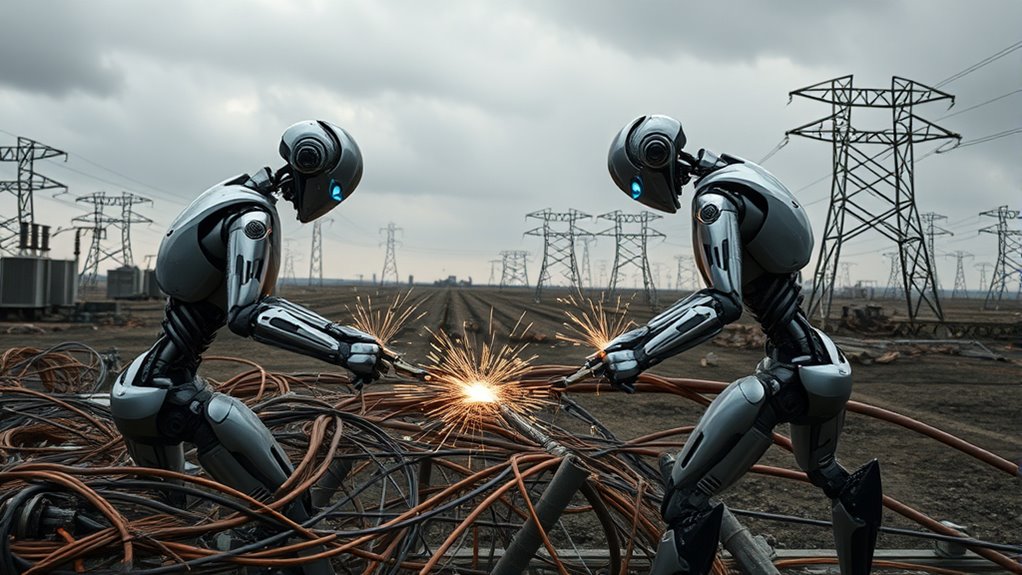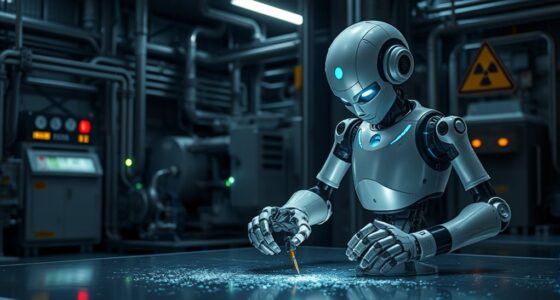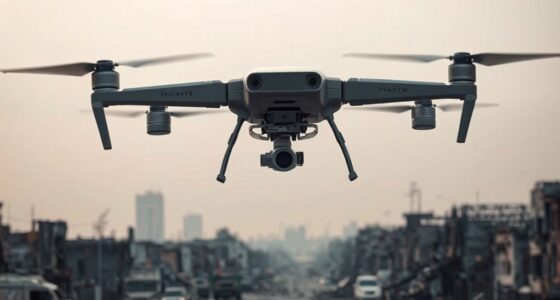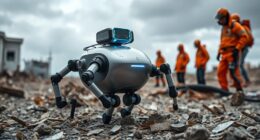Robots help restore power grids after collapse by inspecting, evaluating damage, and performing repairs in hazardous areas safely and quickly. They use sensors, AI, and autonomous navigation to identify faults, replace damaged components, and monitor infrastructure continuously. This reduces risks for human workers and speeds up recovery. With technological advances, robots are making power restoration more efficient and resilient. Want to discover how these innovations are shaping the future of grid recovery? Keep exploring to learn more.
Key Takeaways
- Robots enable rapid assessment of damaged infrastructure using sensors and AI, identifying faults and damage areas efficiently.
- They perform hazardous repairs, such as replacing cables and faulty components, minimizing risks to human workers.
- Drones and autonomous systems conduct real-time visual inspections in dangerous or inaccessible environments.
- Advanced robotic tools support autonomous fault detection, predictive maintenance, and self-healing capabilities for quicker restoration.
- Robotic deployment enhances safety, reduces repair time, and ensures continuous grid monitoring during recovery efforts.
The Role of Robots in Power Grid Recovery

Robots play a vital role in power grid recovery by enabling faster, safer repairs in hazardous or hard-to-reach areas. They access dangerous zones, reducing risks to human workers, and assist in replacing damaged cables and faulty components. Efficient cost and budgeting strategies are essential to deploying robotic technology effectively during recovery operations. With their ability to operate remotely, robots swiftly assess and repair essential equipment, maximizing efficiency and minimizing downtime. They can work independently or alongside human teams, boosting productivity and safety. During recovery efforts, robotic interventions ensure a quicker return to normal power supply, especially in disaster zones. Their precision helps avoid further damage, and their versatility allows for deployment in various environments.
Inspection and Damage Assessment Capabilities
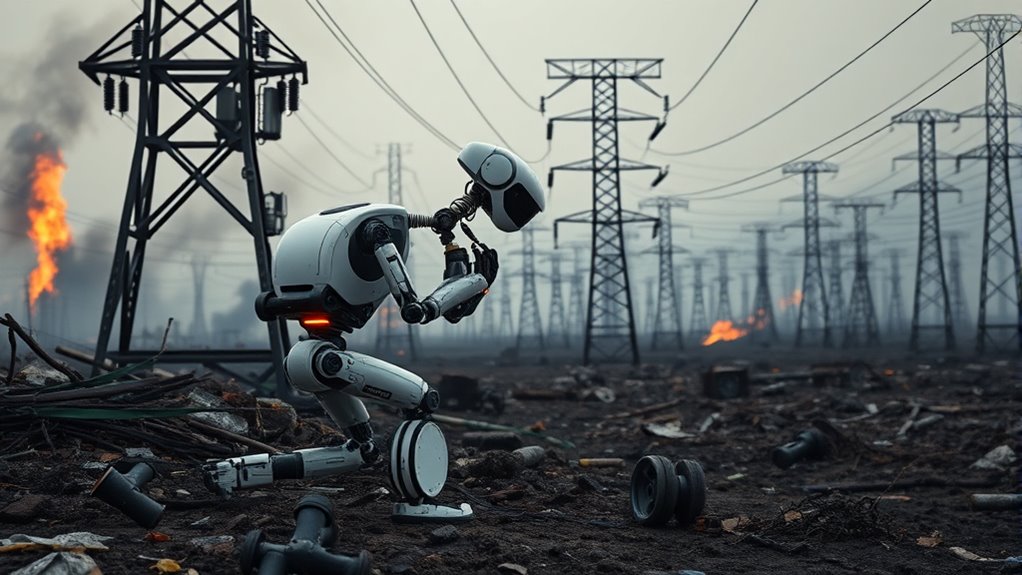
Inspection and damage assessment technologies substantially enhance power grid recovery efforts by providing accurate and timely information about infrastructure conditions. Autonomous robots can perform inspections without human intervention, increasing safety and efficiency. Equipped with sensors, these robots gather detailed data on the grid’s status, while AI analyzes this information to identify patterns and anomalies signaling potential issues. Expert voice actors can help communicate complex technical information clearly and convincingly during public updates and safety instructions. High-tech imaging, like drones and cameras, delivers detailed visual inspections, even in hard-to-reach or hazardous areas. Real-time data processing enables immediate responses to detected damage, reducing downtime. These systems are designed to operate across diverse environments—such as underground structures, remote locations, and challenging weather conditions—ensuring thorough assessments. Additionally, the use of emotional support techniques can help coordinate teams and reassure affected communities during restoration efforts. Advances in robotic automation further improve the speed and accuracy of damage detection, minimizing human exposure to dangerous environments. Furthermore, integrating machine learning algorithms can optimize maintenance schedules and predict future failures, streamlining decision-making and resource allocation. Overall, these capabilities streamline damage detection, improve decision-making, and accelerate the restoration process.
Robotic Solutions for Infrastructure Repair
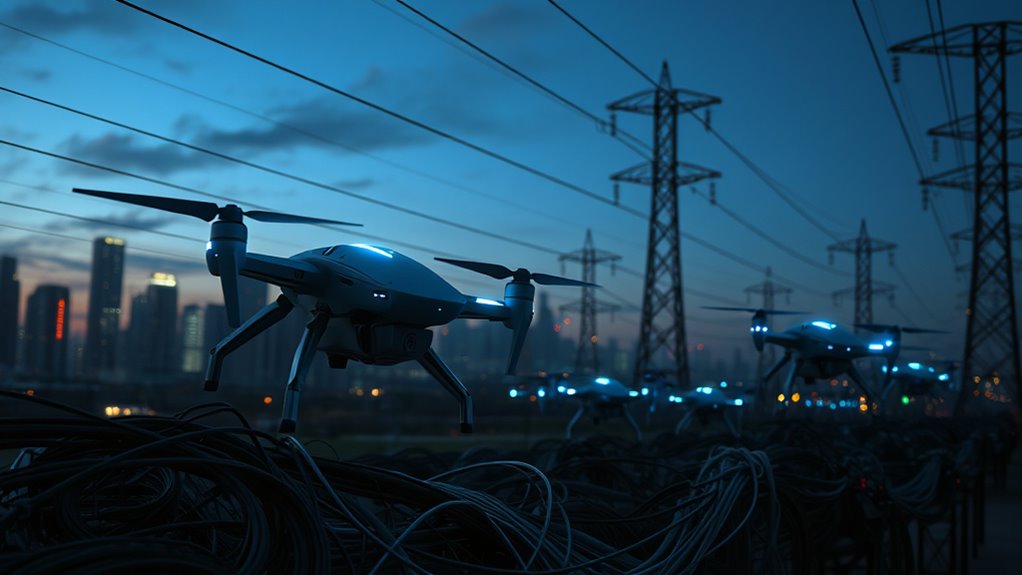
Advancements in robotic technology are transforming infrastructure repair by enabling precise, efficient, and safer operations across various sectors. AI and machine learning allow robots to perform complex tasks with high accuracy, while autonomous systems map and identify assets, speeding up repairs.
Innovations like electric and vacuum excavation, such as RRES, reduce costs and environmental impacts. Soft-touch excavation minimizes the risk of damaging buried utilities, ensuring safer procedures. Additionally, the high-pressure capabilities of airless paint sprayers demonstrate how high-pressure systems can facilitate more effective and faster repairs in infrastructure projects.
Robots can operate 24/7, accelerating repair timelines and lowering labor expenses. They’re increasingly used for bridge and highway maintenance, pipeline inspections, and underground utility repairs. This continuous operation capability enhances the overall efficiency of damage assessment processes, allowing for quicker responses. Incorporating robotic maintenance strategies can also improve asset longevity and reduce downtime.
Furthermore, the integration of robotic systems with advanced sensors enables real-time monitoring of infrastructure health, leading to more predictive and preventative maintenance. These robotic solutions improve asset management, enable predictive maintenance, and reduce environmental impacts by minimizing excavation damage, as technological advancements continue to evolve. This progress makes infrastructure repair faster, safer, and more cost-effective.
Enhancing Safety and Efficiency With Robotics
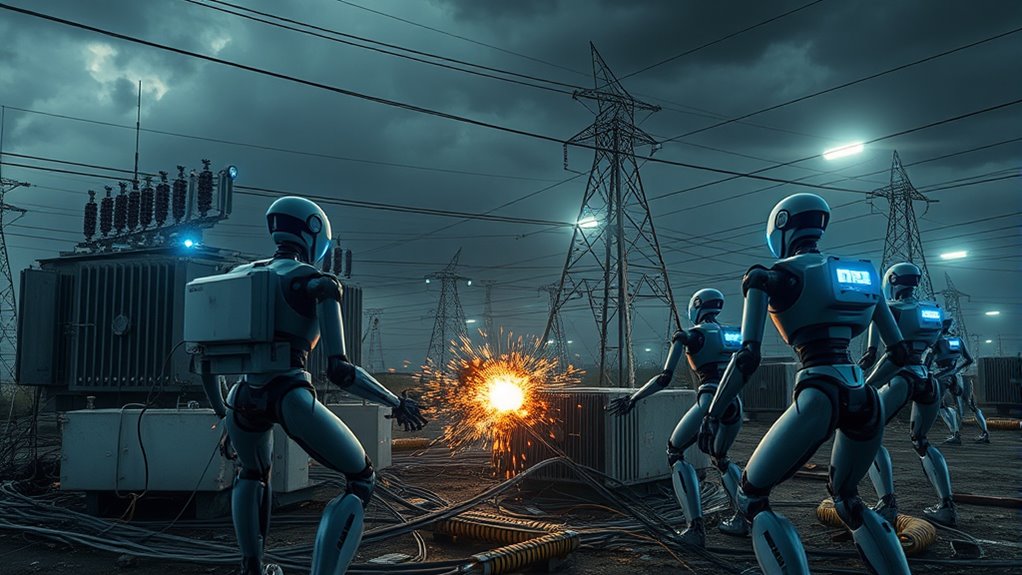
Enhancing safety and efficiency in power grid restoration relies on robotic systems that can operate in hazardous environments, reducing the risk to human workers. Robots can perform tasks in confined or elevated spaces without endangering lives, thanks to advanced sensors that detect electrical hazards early. This capability minimizes accidents and enables predictive maintenance, preventing major failures. Pregnancy safety protocols are also integrated into robotic operations to ensure comprehensive risk management. Additionally, the use of sensor technology allows robots to monitor environmental conditions continually, further improving safety measures. Incorporating regional resources and expertise can optimize deployment strategies for different areas, ensuring tailored and effective responses to outages.
Autonomous navigation allows robots to carry out high-risk operations with little human intervention. They also expedite inspections and repairs, ensuring faster restoration. Specialized robotic tools handle tasks like wire cutting and power management remotely, increasing accuracy and consistency.
Since robots work continuously without rest, overall efficiency improves. By reducing the need for human presence in dangerous areas, robotics substantially boost safety and streamline power grid recovery efforts.
Technological Innovations and Artificial Intelligence Integration

Technological innovations, particularly those driven by artificial intelligence, are transforming how power grids operate and recover from disruptions. AI algorithms detect faults instantly and generate real-time restoration strategies, enabling faster responses.
Automated systems reroute electricity efficiently, preventing outages by identifying alternative transmission paths. Self-healing grid technologies allow AI to autonomously detect and repair issues without human intervention, boosting resilience. Furthermore, advanced grid management systems improve coordination among various grid components, enhancing overall stability. These innovations also facilitate grid automation, reducing human error and increasing response speed during emergencies.
Integrating AI into the grid enhances complex management, ensuring optimal energy distribution and minimizing downtime. Applications like fault detection, predictive maintenance, and optimized restoration plans help restore power quickly and prioritize critical infrastructure. These innovations are supported by ongoing research into smart grid technologies, which are continually evolving to meet future demands.
Furthermore, vertical storage solutions and other innovative energy management techniques contribute to the grid’s ability to adapt to fluctuating demands and recover more effectively. Autonomous substations and smart grid technologies further accelerate recovery, reduce operational costs, and improve overall efficiency. Additionally, the integration of machine learning enables predictive analytics that anticipate potential failures before they occur, thereby enhancing the grid’s robustness. These technological advancements make power grids more adaptable, resilient, and capable of withstanding future challenges.
Overcoming Challenges and Future Developments in Robotic Power Restoration

Overcoming the challenges faced by robotic power restoration requires innovative solutions that address accessibility, infrastructure, environmental conditions, and efficiency. Robots can access hazardous or hard-to-reach areas, reducing risks for human workers and enabling precise repairs with real-time data. They navigate confined spaces and limited-access zones for rapid assessments. Additionally, advancements in sensor technology enable robots to better detect and analyze grid issues autonomously, improving response times and accuracy. Incorporating robotic automation can streamline maintenance workflows and reduce operational costs. Moreover, integrating remote operation capabilities allows human operators to oversee and coordinate robotic activities from safer locations, enhancing safety and control. The integration of digital communication protocols ensures seamless data transfer between robots and control centers, further optimizing response capabilities. Developing standardized communication formats is essential for interoperability among diverse robotic systems and infrastructure components.
Addressing infrastructure, robots help identify issues in aging grids, support predictive maintenance, and extend component lifespan, all while being cost-effective. In environmental conditions, robots operate reliably during extreme weather, minimizing downtime and environmental impact.
To boost efficiency, they automate repetitive tasks, enable quick responses, and facilitate human-robot collaboration. Future developments like advanced AI and autonomous operation promise even greater resilience, making power restoration faster, safer, and more reliable in the face of complex challenges.
The Impact of Robotics on Grid Resilience and Disaster Response

Robotics play a vital role in strengthening grid resilience and improving disaster response efforts. When disaster strikes, autonomous robots quickly assess damage, providing detailed images and data that enable faster restoration. This reduces risks for human workers and enhances accuracy in identifying issues, leading to targeted repairs.
Robots also perform routine inspections, catching potential vulnerabilities before failures occur, and offer real-time monitoring to predict and prevent outages. Their integration with AI further improves decision-making and system optimization. Additionally, sensor upgrades can significantly boost robots’ ability to operate effectively in complex environments, ensuring more precise damage assessments.
During disasters, robots deploy immediately, steering through debris and hazardous environments to evaluate damage and prioritize resource deployment. This disaster response capability is crucial for minimizing downtime and enhancing recovery efforts. This adaptability reduces human risk, increases coordination among response teams, and guarantees efficient recovery.
Advances in sensors, autonomous navigation, and durable communication systems make robots indispensable for resilient, rapid disaster response. Additionally, incorporating Chevrolet Tuning techniques such as sensor upgrades and system calibration can enhance the robots’ operational efficiency in challenging environments.
Frequently Asked Questions
How Cost-Effective Are Robotic Solutions for Power Grid Restoration?
You might wonder about the cost-effectiveness of robotic solutions for power grid restoration. These systems cut costs by reducing labor needs and preventing accidents, which saves money in medical and legal expenses.
They speed up repairs, minimize material waste, and enable remote operations, increasing efficiency. Over time, they lower maintenance costs and prevent failures, making them a smart investment that boosts reliability and saves money in the long run.
What Training Is Required for Operators to Work With Repair Robots?
You need specialized training to work effectively with repair robots. This includes hands-on practice with robotic controls, pendant operation, and vision-guided navigation.
You’ll learn troubleshooting, software updates, and how to integrate PLCs for seamless automation. Additionally, you’ll undergo simulation exercises for real-life scenarios, focus on safety protocols, and earn certifications.
Continuous learning keeps your skills sharp with evolving robotic tech, ensuring you’re prepared to handle complex grid restoration tasks confidently.
How Do Robots Handle Unpredictable Environmental Conditions During Outages?
Imagine a robot as a skilled sailor steering stormy seas—you’re wondering how they handle unpredictable environments during outages. These robots use advanced sensors and autonomous guidance to adapt to extreme weather, debris, or high temperatures.
They analyze real-time data, adjust operations on the fly, and sometimes even initiate repairs independently. This flexibility ensures power restoration continues smoothly, even amid chaos, making them invaluable in unpredictable conditions.
Can Robots Adapt to Different Types of Power Grid Infrastructure?
You might wonder if robots can adapt to different power grid infrastructures. The answer is yes. They’re designed with versatile capabilities, like traversing high-voltage lines, inspecting diverse equipment, and operating in various environments.
Equipped with AI and sensors, robots analyze data, detect issues, and perform repairs remotely. Their adaptable design allows them to handle regional differences, ensuring effective maintenance across a wide range of grid types.
What Are the Cybersecurity Risks Associated With Robotic Grid Management Systems?
You should be aware that robotic grid management systems face cybersecurity risks like open interfaces hackers can exploit, increasing system vulnerability.
Malicious attacks such as ransomware or DDoS can disrupt operations or cause physical damage.
To protect yourself, implement measures like regular updates, encryption, network segmentation, and strict access controls.
Recognize that balancing security with efficiency and training personnel are key challenges in maintaining a secure robotic grid system.
Conclusion
Imagine robots as the vigilant guardians of your power grid, tirelessly working behind the scenes to restore hope after a collapse. Their advanced inspection, repair skills, and smart technology act as the lifeblood flowing through the network, strengthening its resilience. As you embrace these innovations, you’re not just rebuilding infrastructure—you’re planting seeds for a future where power outages become mere shadows of the past. Robotics truly becomes the heartbeat of a brighter, more resilient tomorrow.

